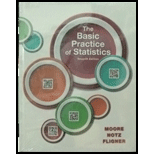
Concept explainers
a.
To estimate: The parameters for the given regression model and also estimate for
a.
Explanation of Solution
Given info:
The dataset shows the calories burnt after running in a treadmill for various speed.
The variables are listed below:
No incline – 1 for 0% incline and 0 for other incline positions.
2% incline – 1 for 2% incline and 0 for other incline positions.
Indslow – 1 for MPH less than or equal to 3 and 0 for greater than 3.
MPH – mile per hour.
Justification:
From the MINITAB output, it can be observed that the parameters in the regression model are as follows:
The estimate for
b.
To find: The number of lines fitted with the given model.
To check: Whether all the slope values are identical.
To identify: Each of the fitted line.
b.
Answer to Problem 29.46E
There are 8 lines fitted with the given model.
The slope values are not identical.
The fitted values are given below:
When Indslow, 2% incline and No incline as 0.
When Indslow as 1, 2% incline and No incline 0.
When Indslow, 2% incline and No incline takes 1.
When Indslow takes 0, 2% incline takes 1 and No incline takes 1.
When Indslow and 2% incline takes 0, No incline takes 1.
When Indslow and 2% incline takes 1, No incline takes 0.
When Indslow takes 0, 2% incline and No incline takes 1.
When Indslow takes 1, 2% incline takes 0 and No incline takes 1.
Explanation of Solution
Calculation:
From the MINITAB output, it can be observed that the regression model predicting calories using the variables No incline, 2% incline, Indslow and MPH are given below:
There are 8 regression lines for predicting calories under different levels of Indslow, No incline, 2% incline:
When Indslow, No incline and 2% incline takes 0, then the regression equation for predicting calories is as follows,
When Indslow takes 1, No incline and 2% incline takes 0, then the regression equation for predicting calories is as follows,
When Indslow, No incline and 2% incline takes 1, then the regression equation for predicting calories is as follows,
When Indslow takes 0, No incline takes 1 and 2% incline takes 0, then the regression equation for predicting calories is as follows,
When Indslow and No incline takes 0 and 2% incline takes 1, then the regression equation for predicting calories is as follows,
When Indslow and No incline takes 1 and 2% incline takes 0, then the regression equation for predicting calories is as follows,
When Indslow takes 0, No incline and 2% incline takes 1, then the regression equation for predicting calories is as follows,
When Indslow takes 1, No incline takes 0 and 2% incline takes 1, then the regression equation for predicting calories is as follows,
Justification:
The slopes are not the same because of indicator variables Indslow, No incline, and 2% incline.
Indicator variable:
An indicator variable places the individual observation in one among the two categories; an indicator variable is coded by the values 0 and 1.
c.
To suggest: Whether the model provides a better fit for the given data.
c.
Answer to Problem 29.46E
The model provides a better fit for the given data.
Explanation of Solution
Justification:
R-square:
The R-square is a multiple
R-square tells about the fit of the model. If the R-square value is high then the model fits better.
From the MINITAB output, it can be seen that the R-square value is 99.3%. This tells that the explanatory variables could explain 99.3% of variation in predicting the calories burnt.
d.
To test: Whether there is any significance that more speed results in more calories burn.
To state: The hypotheses, test-statistic and the P-value.
d.
Answer to Problem 29.46E
There is significance that more speed results in more calories burn.
The hypothesis used for testing the significant in the speed is given below:
The test statistic value is 56.17 and P-value is 0.000.
Explanation of Solution
Justification:
The hypothesis used for testing the significant in the speed is given below:
Where,
Test statistic:
b represents the estimate for
From the MINITAB output, it can be observed that the P-value corresponding to the variable MPH is 0.000 which is lesser than the level of significance
Hence, conclude that there is significance that more speed results in more calories burn.
Conclusion:
From this data and the output, it is clear that burning calories depend on the individual and it is not in the hands of other things like equipments because the variable MPH turns out to be significant and its coefficient is 145.841. Thus, if speed increases calories burn will also increase.
Want to see more full solutions like this?
Chapter 29 Solutions
Bundle: Basic Practice of Statistics 7e & LaunchPad (Twelve Month Access)
 MATLAB: An Introduction with ApplicationsStatisticsISBN:9781119256830Author:Amos GilatPublisher:John Wiley & Sons Inc
MATLAB: An Introduction with ApplicationsStatisticsISBN:9781119256830Author:Amos GilatPublisher:John Wiley & Sons Inc Probability and Statistics for Engineering and th...StatisticsISBN:9781305251809Author:Jay L. DevorePublisher:Cengage Learning
Probability and Statistics for Engineering and th...StatisticsISBN:9781305251809Author:Jay L. DevorePublisher:Cengage Learning Statistics for The Behavioral Sciences (MindTap C...StatisticsISBN:9781305504912Author:Frederick J Gravetter, Larry B. WallnauPublisher:Cengage Learning
Statistics for The Behavioral Sciences (MindTap C...StatisticsISBN:9781305504912Author:Frederick J Gravetter, Larry B. WallnauPublisher:Cengage Learning Elementary Statistics: Picturing the World (7th E...StatisticsISBN:9780134683416Author:Ron Larson, Betsy FarberPublisher:PEARSON
Elementary Statistics: Picturing the World (7th E...StatisticsISBN:9780134683416Author:Ron Larson, Betsy FarberPublisher:PEARSON The Basic Practice of StatisticsStatisticsISBN:9781319042578Author:David S. Moore, William I. Notz, Michael A. FlignerPublisher:W. H. Freeman
The Basic Practice of StatisticsStatisticsISBN:9781319042578Author:David S. Moore, William I. Notz, Michael A. FlignerPublisher:W. H. Freeman Introduction to the Practice of StatisticsStatisticsISBN:9781319013387Author:David S. Moore, George P. McCabe, Bruce A. CraigPublisher:W. H. Freeman
Introduction to the Practice of StatisticsStatisticsISBN:9781319013387Author:David S. Moore, George P. McCabe, Bruce A. CraigPublisher:W. H. Freeman





